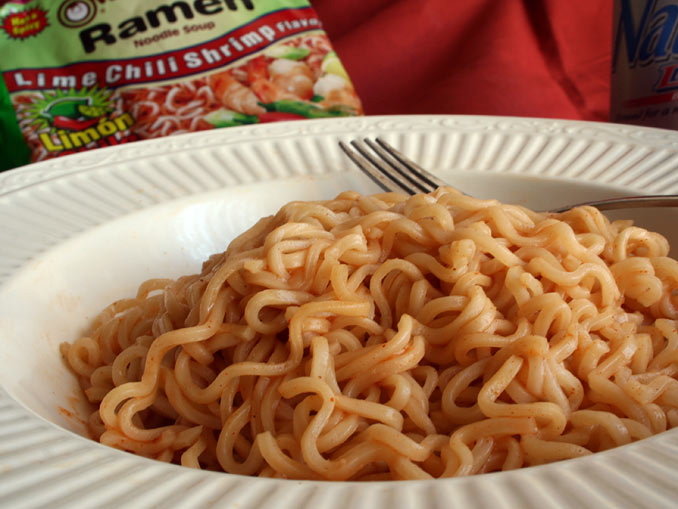Ramen noodles have the reputation as being a "poor college kid’s" cuisine, right along with boxes of mac 'n' cheese and cases of Huber beer, but the reality of the dirt-cheap Asian pasta is that they are easily upgraded to an A+ dish.
Ramen noodles cost between 25 and 50 cents per package and come in a variety of flavors, including beef, chicken, shrimp and the elusive "Oriental" flavor.
Unfortunately, ramen is not a perfect food. It’s high in carbs and low in vitamins and minerals. To remove the water and form them into blocks, ramen is deep fried in palm oil, which is extremely high in saturated fat. Plus, if the packet is added, the dish is suddenly super high in sodium (about 150 milligrams).
However, adding healthy ingredients redeems ramen, and most likely, a few items in your fridge or a quick trip to the grocery store will fancy up your meal.
While food prices continue to rise, revisiting ramen is fun and frugal, so OnMilwaukee.com consulted local chefs, restaurant owners and foodies to find out how to take ramen to the next level.
"There are a million and one things to do with ramen," says Ross Bachhuber, executive chef for the Diablos Rojos Group. "It’s a really versatile noodle and can be jazzed up by almost anything."
Bachhuber, who creates cuisine at Cafe Centraal, 2306 S. Kinnickinnic Ave., Cafe Hollander, 2608 N. Downer Ave., and Trocadero, 1758 N. Water St., suggests a variety of ingredients.
"First, throw the seasoning packet away," he says. "Then, pick up some fresh ingredients like scallions, ginger, garlic, fresh chilies, limes, cilantro, thai basil, sprouts, cucumber, snap peas, carrots, cabbage, broccoli, spinach and tofu. Pretty much anything you would want in a great stir fry or salad."
When Bachhuber was in chef school he says he experimented with ramen recipes.
"I remember whisking together Dijon mustard, a splash of Worcestershire, a splash of Tabasco, steamy cooked ramen noodles, a splash of vodka and some hot Campbell's tomato soup to create a bloody mary ramen," he says. "Garnished with a pickle. Who could ask for a healthier, more well-balanced meal?"
Nick Burki is the new co-owner of Coquette Cafe, 316 N. Milwaukee St., and he admits to occasionally indulging in ramen.
"I get slightly naughty with a little miso, edamame, shiitake mushrooms, scallions, bok choy and some grilled salmon," says Burki, whose experience includes The Social and Cafe Calatrava at the Milwaukee Art Museum. "Or, a little ramen with braised pork belly, littleneck clams, sweet corn and potato."
Kyle Cherek, the host of the CBS television show, "Wisconsin Foodie," says that ramen noodles, although originally from China, were popularized by the Japanese. ("Ramen" is the Japanese pronunciation of the Chinese characters "lo mein" which means "boiled noodles.")
"In a way, ramen noodles has a rags to riches story," says Cherek. "It’s a centuries-old Chinese dish that, as of late, has been exalted through the likes of (chef) David Chang and his culinary denizens."
Milwaukee’s Elaine Litzau spends time in her kitchen perfecting ramen-based recipes. And she is no spice packet snob.
"I put a green vegetable like broccoli, green beans, frozen peas, chinese cabbage in the water with the noodle block on top. When the water starts to boil, I push the noodles under the water, beneath the vegetables, then break the noodles up. Then, I add the spice packet," she says.
"When that is all mixed in, I crack an egg into the pot and stir it up. Sometimes, if I have it, I add leftover chicken or pork into the mix, too."
Litzau, whose mother is from Japan, says she considers ramen a comfort food.
"The best ramen I ever ate was in Japan, of course, but you can get really good ramen in Milwaukee at several of the Japanese restaurants," she says.
Litzau recommends ramen dishes from Nanakusa Japanese Restaurant, 408 E. Chicago St., and Izumi's, 2150 N. Prospect Ave.
Ramen noodles can be eaten raw -- crunched up in an Asian cole slaw, for example -- but technically there are two ways to eat cooked ramen noodles. Some people prefer them floating in broth -- as a soup -- whereas others eat ramen more like spaghetti.
"I was stupified the first time I saw one of my college roommates make a package of ramen, only to pour all the soup out of the pot, plop the noodles on a plate and then proceed to eat them like a pasta," says Litzau. "Since that incident, I've learned that many people eat them like that, but I think it's just plain wrong."
Both Litzau and Cherek agree that the noodles are simply not the star of the ramen show.
"It’s really all about the broth," says Cherek.
Molly Snyder started writing and publishing her work at the age 10, when her community newspaper printed her poem, "The Unicorn.” Since then, she's expanded beyond the subject of mythical creatures and written in many different mediums but, nearest and dearest to her heart, thousands of articles for OnMilwaukee.
Molly is a regular contributor to FOX6 News and numerous radio stations as well as the co-host of "Dandelions: A Podcast For Women.” She's received five Milwaukee Press Club Awards, served as the Pfister Narrator and is the Wisconsin State Fair’s Celebrity Cream Puff Eating Champion of 2019.



